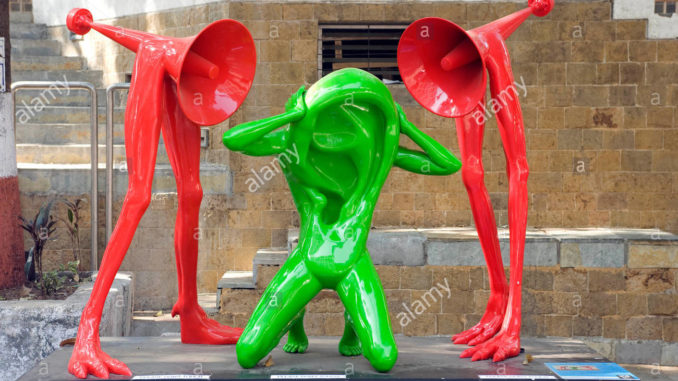
Ambient noise pollution on Indian roads goes unbridled and it is perceptibly maddening. The WHO’s guidelines for noise quality recommend less than 30 A-weighted decibles in bedrooms during the night for a sleep of good quality and less than 35 in classromms to allow good teaching and learning conditions. Recommendations for night noise outside of bedrooms are less than 40 dB (A) of the annual average to prevent adverse health effects.The actual level of external noise is dangerously high and factorised by multiple social, behavioural and technological reasons. Noise is nevertheless an underestimated threat in India and most of us are ignorant of the fact that it can cause several short and long term health problems such as tinnitus and hearing loss, cardiovascular and psycho-physiological effects.
Roads are the biggest noise pollutants and vehicle manufacturers are seemingly not taking responsibility in reducing the level of noise pollution by continuously producing loud horns. These horns, sometimes, have uniquely shocking sounds that are customised to surprise others on the roads. Moreover, drivers are overusing their horns and honking incessantly where they essentially don’t need to alert anybody about their movement.
Besides the roads, unwanted sources of noise have also penetrated supposedly peaceful living areas. Major contributors of noise pollution include vegetable vendors who install cheap, bothersome loudspeakers to announce their goods at an irritating and unhealthy level of loudness. Recorded messages from repairers, scrap dealers or donation seekers in the street is another everyday issue which simply escalates noise pollution.
Two overarching interventional approaches worth considering in combating the issue of noise pollution are –
- reduction of the source’s nose and controlling/restraining activities,
- developing effective shelter against the noise.
As part of the first approach, the government might like to instruct the automobile manufacturers to standardise honking sound levels within a threshold limit. The govt. should also consider rolling out ‘behaviour-change interventions’ to encourage drivers to regulate their horn usage. Establishing specific areas as silence zones where honking and loudspeakers are prohibited, especially near hospitals, schools and residential sites are certain measures in controlling noise pollution.
The second approach, which is in developing shelter against ambient noise, may involve techniques of noise absorption ore deflection which can be applied in external (in towns and cities) or internal (homes) environments. In order to lessen the negative effects of ambient noise, special emphasis has to be given to noise control policy in urban planning. Various tried and tested techniques have been applied both abroad and in India as a means to reduce the pollution.
Adapting curtain walls for homes and balconies, introducing the angular features in building designs and applying noise absorbing materials or barriers to noise are all practical ways in which to dramatically reduce ambient noise around home. Certain feasible absorbents or barriers are green hedges, pavements with low noise surfacing and vibration and acoustic hedge around railway tracks. In terms of the external environment, many interventional approaches have been proven successful around the world. These approaches range from using alternative roads or bypasses, decreasing traffic and speed limits and better car tyre management. Ways to ensure that these ‘shelters’ against ambient noise are sustained health and environmental education programmes, compensation for the exposed people and better scientific research.
noise abatement starts-aside from technical imrovements and legislations- in the mind of each individual. Therefore, development of low-noise road use behaviour takes centre stage amongst all interventional approaches.
Matter Referenced: Times of India, Ahmedabad, Tuesday, 9th October, 2018.
By: Dr. Bhawana Asnani.
Happy to see Reviews, Additions, Suggestions and Comments, further.

Leave a Reply
You must be logged in to post a comment.